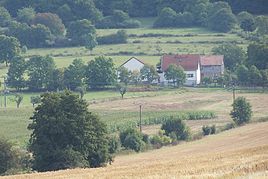Oberrothhof
|
Oberrothhof
Schleid municipality
Coordinates: 50 ° 41 ′ 3 ″ N , 9 ° 59 ′ 15 ″ E
|
||
|---|---|---|
| Height : | 385.2 m above sea level NN | |
| Postal code : | 36419 | |
| Area code : | 036967 | |
|
Location of Oberrothhof in Thuringia |
||
|
View to the northern homestead of Oberrothhof.
|
||
The Oberrothhof consists of two farms and belongs to Schleid in the Wartburg district in Thuringia .
location
The Oberrothhof district is located on the Hessian-Thuringian border in the Rhön Biosphere Reserve in an area open to the west and bordered by forest to the east. The Roßberg with 693.6 m above sea level. NN is the highest mountain near Schleid. The geographic height of the place is 385.2 m above sea level. NN .
history
The farm was first mentioned in a document on October 4, 1309. In the field corridor next to the northern homestead you can still see the construction of field stiffeners from the late medieval phase of settlement. The farm is located just below the edge of the forest and on the edge of the moderately steep slope. The place name refers to a group of farmsteads that were probably built at the same time in the vicinity (3 km as the crow flies) of the Fulda district castle Rockenstuhl and this castle served as farmyards.
Trivia
The Motzlar volunteer fire brigade made a curious find in early May 2009 when it was deployed at the Oberrothof extinguishing water pond . A fully grown beaver had appeared at the edge of the pond - according to information from the nature conservation authority, the first specimen copy in the Wartburg district. Genetic tests should prove whether the shy animal comes from Hesse or from the population located near Meiningen. The examinations revealed evidence of a European beaver who had probably immigrated from the southern Hessian region. The beaver was released on the Ulsterufer a few days later.
Individual evidence
- ↑ Official topographic maps of Thuringia 1: 10,000. Wartburgkreis, district of Gotha, district-free city of Eisenach . In: Thuringian Land Survey Office (Hrsg.): CD-ROM series Top10 . CD 2. Erfurt 1999.
- ^ Wolfgang Kahl : First mention of Thuringian towns and villages. A manual. Rockstuhl Verlag, Bad Langensalza, 2010, ISBN 978-3-86777-202-0 , p. 209
- ↑ Ute Weilbach: Biber is healthy, eats and bathes. Initial detection in the Wartburg district / hair and faeces samples are examined by the end of the week. Südthüringer Zeitung (editorial office Bad Salzungen), May 5, 2009, accessed on September 30, 2012 : “What kind of beaver belongs that has migrated to Motzlar is now being investigated. The next beaver occurrences are known west of Fulda / Hünfeld and north of Meiningen. ... Of course, the goal is to release the beaver as quickly as possible. But it must be known whether it is a European or a Canadian beaver. If it is a Canadian beaver, the animal has been abandoned and needs a care place. It cannot be released into the wild. If it is a European beaver, an Elbe beaver (Saxony-Anhalt), an Eastern European beaver or a Scandinavian beaver (Bavaria), nothing stands in the way of a release. As Heck explains, beavers are subject to strict species protection. The species had decreased to 100 animals in Germany. Beavers only survived on the Elbe. In the 1980s they were released into the wild in Hesse (Spessart) and Bavaria to preserve the species. In Hesse the European beaver was chosen, in Bavaria the Eastern European beaver and Scandinavian beaver were poached. "
- ↑ Ute Weilbach: Beavers released again / citizens should report observations to the authorities. Südthüringer Zeitung (editorial office Bad Salzungen), March 25, 2010, accessed on September 30, 2012 : “The beaver currently weighs 20 kilograms. His age must be between two and four years. So it is a growing animal, which is separated from its parents' den and is looking for its own territory. These wandering beavers can travel up to 25 to 30 kilometers. So it could come from the area near Fulda. In the Fulda and its tributaries there are again individual beavers after 150 years. "

